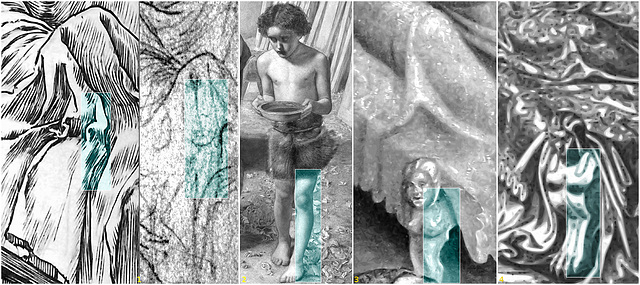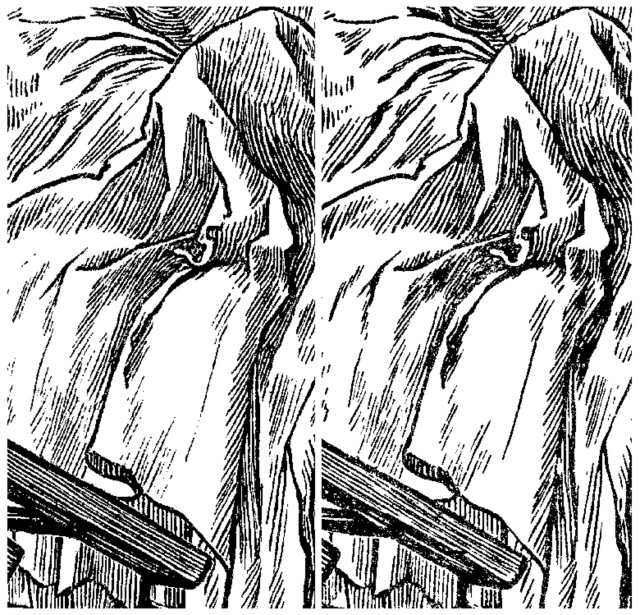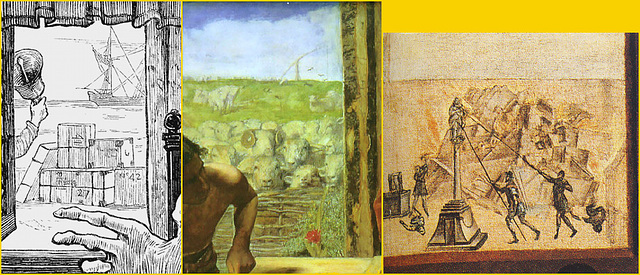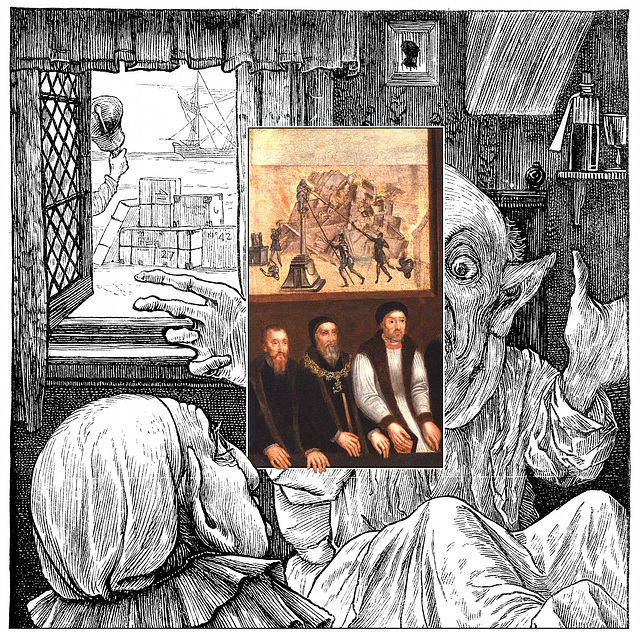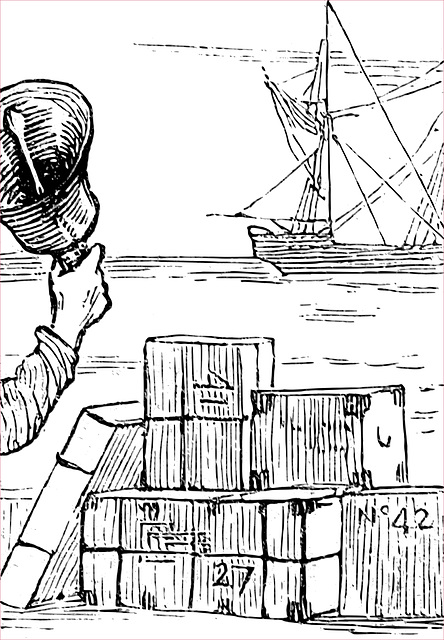
The Hunting of the Snark
Folder: The Hunting of the Snark
All Snark. (My Snark favorites are here: www.ipernity.com/doc/goetzkluge/album/410701)
02 Nov 2014
2 favorites
3 comments
Holiday - Millais - Anonymous - Galle; detail
#1, left - (allusion to the bedpost #3): 1876, Henry Holiday (engraver: Joseph Swain): The illustration detail on the very left side is a vectorized scan from Holiday's illustration to an 1910 edition of Lewis Carroll's The Hunting of the Snark .
#1, right: Additionally you see a segment from Holiday's preperatory draft.
#2 - (allusion to the bedpost #3 and to Philip Galle's print #4): 1850, the young John the Baptist in John Everett Millais : Christ in the House of His Parents (aka The Carpenter's Shop ). The left leg of the boy looks a bit deformed. This is no mistake. Probably Millais referred to #3 and to #4.
#3 - (Henry VIII's bedpost): 16th century, anonymous: Redrawn segment of Edward VI and the Pope, An Allegory of Reformation , (mirror view).
#4 - (bedpost #3 alludes to bedpost #4): 1564, Redrawn segment of a print Ahasuerus consulting the records by Philip Galle after Maarten van Heemskerck. The resemblance of #4 to the image #3 (the bedpost) was shown by the late Dr. Margaret Aston in 1994 in The King's Bedpost: Reformation and Iconography in a Tudor Group Portrait (p. 68). She also compared the bedpost to Heemskerck's Esther Crowned by Ahasuerus .
17 Dec 2014
1 comment
Uncle's Blanket
Segment from an illustration by Henry Holiday (engraver: Joseph Swain) to Lewis Carroll's "The Hunting of the Snark". Publisher: MACMILLAN AND CO.
left: 1876
R. CLAY, SONS, AND TAYLOR, PRINTERS
Signature: SWAIN S.C.
(scaled down to the size of the miniature edition)
right: 1910, 2nd Miniature Edition
R. CLAY AND SONS, LIMITED
Signature: SWAIN S.C.
I don't see significant differences and assume, that the 1910 image is a reworked photographic reproduction of the 1876 image.
05 Jun 2010
1 comment
42 Boxes, Sheep, Iconoclasm
[left]: Segment from Henry Holiday's depiction of the Baker's visit to his uncle (1876) in Lewis Carroll's The Hunting of the Snark . Outside of the window are some of the Baker's 42 boxes.
[center]: Segment from John Everett Millais : Christ in the House of His Parents (1850).
[right]: segment from Edward VI and the Pope , An Allegory of Reformation , mirrored view (Anonymous, 16th century); depiction of iconoclasm. In The King's Bedpost: Reformation and Iconography in a Tudor Group Portrait (1994, p. 72), the late Margaret Aston compared the iconoclastic scene to prints depicting the destruction of the Tower of Babel (Philip Galle after Maarten van Heemskerck, 1567). From Margaret Aston's book I learned that the section showing the iconoclasm scene is an inset, not a window. Actually, I think, it is an inset which was meant to be perceived as a window as well.
·
Holiday quoted pictorial elements from both paintings [center, right]. I assume that he must have noticed, that Millais quoted from the 16th century painting.
02 Jun 2013
1 comment
The Broker's and the Monk's Nose
[left]: Segment from an illustration by Henry Holiday to Lewis Carroll's The Hunting of the Snark depicting the Broker (upper left corner). The object he is holding at his lips is the handle of a malacca walking cane, a gesture associated with dandies in the Victorian era.
[right]: Segment from anonymous: Edward VI and the Pope , a Tudor anti-papal allegory of reformation (16th century).
Holidays Snark illustrations are conundrums. And the were constructed as conundrums. The pattern in the frame (2) on the left side is an allusion to a rather unobstrusive pattern on the right side. This shows that Holiday did not "copy" patterns just because of they would contribute to the impressiveness of his illustrations.
·
In 1922 (46 years after The Hunting of the Snark was published), Henry Holiday (the illustrator) wrote to George Sutcliffe (Sangorski & Sutcliffe, bookbinders, London): "... you will notice that the Broker in [the proof of the illustration to The Crew on Board ] no. 5 is quite different to the one in [ the later proof ] no. 2. I had intended to give a caricature a the vulgar specimen of the profession, but Lewis Carroll took exception to this and asked me to treat the head in a less aggressive manner, and no. 2 is the result. I consider that no. 5 has much more character, but I understood L. Carroll's objection and agreed to tone him down. ..."
Charles Mitchel called the first design of the broker's face in the lower right corner of the print "conspiciously antisemitic". The change of the printing blocks must have been very important to Carroll, as it took the wood cutter Swain quite some effort to implement that change (see p. 102, Lewis Carroll's The Hunting of the Snark , 1981 William Kaufmann edition).
As shown in the image above, the broker's face also appears in the upper left section of Holiday's illustration to The Hunting . Rather than by a "Semitic" face, Holiday may have been inspired by what could be a cliché of the face of a roman catholic monk depicted in the 16th century anti-papal painting Edward VI and the Pope .
18 Jan 2014
2 comments
The Broker's and the Monk's Nose (with a little help)
[left]: Segment from an illustration by Henry Holiday to Lewis Carroll's The Hunting of the Snark depicting the Broker (upper left corner). The object he is holding at his lips is the handle of a malacca walking cane, a gesture associated with dandies in the Victorian era.
[right]: Segment from anonymous: Edward VI and the Pope , a Tudor anti-papal allegory of reformation (16th century).
Holidays Snark illustrations are conundrums. And they were constructed as conundrums. The colored boxes are meant as a little help to you. There is not only a relation between the patterns marked by the same color, also the topological relation between the patterns on the left side and the right side show some similarity.
The pattern in the orange frame on the lower left side clearly is an allusion to a rather unobtrusive pattern on the right side. This shows that Holiday did not "copy" patterns just because of they would contribute to the impressiveness of his illustrations. Holiday is not a plagiarist.
·
In 1922 (46 years after The Hunting of the Snark was published), Henry Holiday (the illustrator) wrote to George Sutcliffe (Sangorski & Sutcliffe, bookbinders, London): "... you will notice that the Broker in [the proof of the illustration to The Crew on Board ] no. 5 is quite different to the one in [ the later proof ] no. 2. I had intended to give a caricature a the vulgar specimen of the profession, but Lewis Carroll took exception to this and asked me to treat the head in a less aggressive manner, and no. 2 is the result. I consider that no. 5 has much more character, but I understood L. Carroll's objection and agreed to tone him down. ..."
Charles Mitchel called the first design of the broker's face in the lower right corner of the print "conspiciously antisemitic". The change of the printing blocks must have been very important to Carroll, as it took the wood cutter Swain quite some effort to implement that change (see p. 102, Lewis Carroll's The Hunting of the Snark , 1981 William Kaufmann edition).
As shown in the image above, the broker's face also appears in the upper left section of Holiday's illustration to The Hunting . Rather than by a "Semitic" face, Holiday may have been inspired by what could be a cliché of the face of a roman catholic monk depicted in the 16th century anti-papal painting Edward VI and the Pope .
·
Links:
※ www.reddit.com/r/museum/comments/4lrs3o/anonymous_king_edward_vi_and_the_pope_estimates
※ www.reddit.com/r/TheHuntingOfTheSnark/comments/3ul02u/the_brokers_and_the_monks_nose
※ www.academia.edu/9890076/The_Broker_and_the_Monk
※ www.facebook.com/snark150/posts/1647429028620386
03 Jun 2013
1 favorite
11 comments
Thomas Cranmer's 42 Boxes
"I personally don't look for secret messages hidden by Carroll in the text; rather, I look at themes and symbols as potential hints as to the sorts of things that were on Carroll's mind at the time."
Darien Graham-Smith , 2005-10-05
The image:
[B&W]: Upper part of Henry Holiday's illustration (1876) to The Baker's Tale in Lewis Carroll's The Hunting of the Snark depicting some of the Baker's 42 boxes piled up outside the window. In 1552, shortly before the early death of Edward VI, Thoma s Cran mer wrote down 42 articles , a protestant doctrine. In Henry Holiday's depiction of the staple of some of the Baker's 42 boxes piled up outside of the window of the Baker's uncle's room also the number 42 is visible.
[color]: Segment from a painting (c. 1570) by an unknown artist ( commons.wikimedia.org/wiki/File:Ed_and_pope.png ).The segment is displayed in a mirrored view. Thomas Cranmer is located on the right side in the mirrored image. (Among other persons in the painting not shown in this segment: Edward VI, Henry VIII).
There is a book about this painting where Thomas Cranmer is identified: Margaret Aston, The King's Bedpost: Reformation and Iconography in a Tudor Group Portrait , 1994.
·
42 and Thomas Cranmer:
How could the number 42 get into anyone's mind? Douglas Adams made that number popular as an answer to everything. (But what was the question?) In The Hitchhiker's Guide to the Galaxy he (similar to many other writers, e.g. Tom Stoppard) challenged his readers with allusions to the works of earlier writers. An earlier writer who had an obvious affinity to the number 42 is known as Lewis Carroll. And, as I learned from John Tufail , "before the 39 articles of Faith that Carroll [the Rev. Dodgson] declined to attest to, there were 42 articles [written by Thomas Cranmer]."
Of course, like Adams, Carroll wouldn't give any good reason for his affinity (not only in the Snark ) to the number 42 either, but he surely knew, that "Forty-Two" is an important number in the history of Anglicanism: In the mind of Charles Lutwidge Dodgson (aka Lewis Carroll) the Forty-Two Articles of Thomas Cranmer surely had their place.
· · · · 021 · · There was one who was famed for the number of things
· · · · 022 · · · · He forgot when he entered the ship:
· · · · 023 · · His umbrella, his watch, all his jewels and rings,
· · · · 024 · · · · And the clothes he had bought for the trip.
· · · · 025 · · He had forty-two boxes , all carefully packed,
· · · · 026 · · · · With his name painted clearly on each:
· · · · 027 · · But, since he omitted to mention the fact,
· · · · 028 · · · · They were all left behind on the beach.
· · · · 029 · · The loss of his clothes hardly mattered, because
· · · · 030 · · · · He had seven coats on when he came,
· · · · 031 · · With three pairs of boots --but the worst of it was,
· · · · 032 · · · · He had wholly forgotten his name.
· · · · 033 · · He would answer to "Hi!" or to any loud cry,
· · · · 034 · · · · Such as " Fry me! " or " Fritter my wig! "
· · · · 035 · · To "What-you-may-call-um!" or "What-was-his-name!"
· · · · 036 · · · · But especially "Thing-um-a-jig!"
· · · · 037 · · While, for those who preferred a more forcible word,
· · · · 038 · · · · He had different names from these:
· · · · 039 · · His intimate friends called him " Candle-ends ,"
· · · · 040 · · · · And his enemies " Toasted-cheese ."
· · · · 041 · · "His form is ungainly--his intellect small--"
· · · · 042 · · · · (So the Bellman would often remark)
· · · · 043 · · "But his courage is perfect! And that, after all,
· · · · 044 · · · · Is the thing that one needs with a Snark."
· · · · 045 · · He would joke with hyenas, returning their stare
· · · · 046 · · · · With an impudent wag of the head :
· · · · 047 · · And he once went a walk, paw-in-paw, with a bear ,
· · · · 048 · · · · "Just to keep up its spirits," he said.
· · · · 049 · · He came as a Baker: but owned, when too late--
· · · · 050 · · · · And it drove the poor Bellman half-mad--
· · · · 051 · · He could only bake Bridecake--for which, I may state,
· · · · 052 · · · · No materials were to be had.
·
·
Background:
The Baker in Lewis Carroll's The Hunting of the Snark has many features in common with Thomas Cramer. Many of his nick names are associated with heat or having been burnt : "Fry me!" or "Fritter my wig!", "Candle-ends" or "Toasted-cheese".
Cranmer later was accused of heresy and had to leave his articles behind him before he heroically recanted his recantations: "On 14 February 1556, he was degraded from his episcopal and sacerdotal offices in preparation for execution. Following his trial, Cranmer was put under intense pressure to recant. Desperately lonely and broken, Cranmer at last signed a series of six recantations, the last of which rejected his entire theological development. Although the more traditional practice was to impose a lesser sentence on recanted heretics, Mary maintained that Cranmer should burn . On 21 March 1556, Cranmer was to recant publicly, using a speech that had been endorsed by the government before suffering his punishment. Instead, he stunned the authorities and the gathered crowd by recanting not his earlier theological positions but the recantations themselves. He then ran to the stake and steadfastly held his right hand, the hand that had signed the recantations, in the fire . His heroic end undid much of the government's planned propaganda against him and his Protestant cause and earned him an honored place in Foxe's catalog of Protestant martyrs." ( Encyclopedia Britannica, 1911 )
"Mary Tudor suppressed the 42 Articles when she returned England to the Catholic faith; however, Cranmer's work became the source of the 39 Articles which Elizabeth I established as the doctrinal foundations of the Church of England. There are two editions of the 39 Articles: those of 1563 are in Latin and those of 1571 are in English." ( Victorian Web )
15 Aug 2011
1 comment
42 Boxes meet the Iconoclasts
[left]: Segment (devided) of Henry Holiday 's depiction of the Baker's visit to his uncle (1876) in Lewis Carroll's The Hunting of the Snark (engraved by Joseph Swain). Outside of the window are some of the Baker's 42 boxes.
[right]: Anonymous : Segment (two times) of Edward VI and the Pope, An Allegory of Reformation , mirrored view (16th century). Iconoclasm depicted in the window. Under the window (see below) is Thomas Cranmer who wrote the 42 Articles in 1552. In The King's Bedpost: Reformation and Iconography in a Tudor Group Portrait (1994, p. 72), the late Margaret Aston compared the iconoclastic scene to prints depicting the destruction of the Tower of Babel (Philip Galle after Maarten van Heemskerck, 1567). From Margaret Aston's book I learned that the section showing the iconoclasm scene is an inset, not a window. Actually, it may have been an inset which was meant to be perceived as a window as well.
27 Feb 2013
3 comments
The Baker's 42 Boxes
(From Lewis Carroll's and Henry Holiday's The Hunting of the Snark , 1876)
· · · · 021 · · There was one who was famed for the number of things
· · · · 022 · · · · He forgot when he entered the ship:
· · · · 023 · · His umbrella, his watch, all his jewels and rings,
· · · · 024 · · · · And the clothes he had bought for the trip.
· · · · 025 · · He had forty-two boxes , all carefully packed,
· · · · 026 · · · · With his name painted clearly on each:
· · · · 027 · · But, since he omitted to mention the fact,
· · · · 028 · · · · They were all left behind on the beach.
· · · · 029 · · The loss of his clothes hardly mattered, because
· · · · 030 · · · · He had seven coats on when he came,
· · · · 031 · · With three pairs of boots --but the worst of it was,
· · · · 032 · · · · He had wholly forgotten his name.
· · · · 033 · · He would answer to "Hi!" or to any loud cry,
· · · · 034 · · · · Such as " Fry me! " or " Fritter my wig! "
· · · · 035 · · To "What-you-may-call-um!" or "What-was-his-name!"
· · · · 036 · · · · But especially "Thing-um-a-jig!"
· · · · 037 · · While, for those who preferred a more forcible word,
· · · · 038 · · · · He had different names from these:
· · · · 039 · · His intimate friends called him " Candle-ends ,"
· · · · 040 · · · · And his enemies " Toasted-cheese ."
· · · · 041 · · "His form is ungainly--his intellect small--"
· · · · 042 · · · · (So the Bellman would often remark)
· · · · 043 · · "But his courage is perfect! And that, after all,
· · · · 044 · · · · Is the thing that one needs with a Snark."
· · · · 045 · · He would joke with hyenas, returning their stare
· · · · 046 · · · · With an impudent wag of the head :
· · · · 047 · · And he once went a walk, paw-in-paw, with a bear ,
· · · · 048 · · · · "Just to keep up its spirits," he said.
· · · · 049 · · He came as a Baker: but owned, when too late--
· · · · 050 · · · · And it drove the poor Bellman half-mad--
· · · · 051 · · He could only bake Bridecake--for which, I may state,
· · · · 052 · · · · No materials were to be had.
My assumption is, that in Carroll's ballad the Baker does not stand for a single person. Rather, he represents curageous (and - once the intellect is small but the courage is perfect - often uncautious) searchers of truth. Put more simply: The baker represents an attitude (or a set of attitudes), e.g. the attitudes of a Corbinian or a Thomas Cranmer , a key figure in the history of the reformation in Europe.
2013-02-02: In Carroll's description of the Baker (see parts printed in boldface), there may be some allusions to someone who got burned . As for "Bridecake", Thomas Cranmer also was (along with Thomas Cromwell) quite a bit involved in the weddings (and divorces) of Henry VIII. The forty-two boxes carried the Baker's name as clearly, as the Anglican Forty-Two Articles are associated with Thomas Cranmer. Here both, the Baker and Cranmer, stand for quite ambivalent heroes. Carroll (Rev. Dodgson) did not subscribe to the later Thirty-Nine Articles.
By the way: Lewis Carroll didn't explain what the number 42 could "mean". And Douglas Adams insisted on having chosen the number 42 arbitrarily.
See also: en.wikipedia.org/wiki/Corbinian#Corbinian.27s_Bear
02 Apr 2010
3 comments
Thomas Cranmer's Burning
The left picture is a segment from an print which shows the burning of Thomas Cranmer .
The right picture is a +135° rotated detail from Henry Holiday's illustration to the final chapter of Lewis Carroll' s The Hunting of the Snark,
In "The annotaded ... Snark", Martin Gardner wrote about Henry Holiday's illustration to the last chapter of Carroll's The Hunting of the Snark : "Thousands of readers must have glanced at this drawing without noticing (though they may have shivered with subliminal perception) the huge, almost transparent head of the Baker, abject terror on his features, as a giant beak (or is it a claw?) seizes his wrist."
· · · · 021 · · There was one who was famed for the number of things
· · · · 022 · · · · He forgot when he entered the ship:
· · · · 023 · · His umbrella, his watch, all his jewels and rings,
· · · · 024 · · · · And the clothes he had bought for the trip.
· · · · 025 · · He had forty-two boxes , all carefully packed,
· · · · 026 · · · · With his name painted clearly on each:
· · · · 027 · · But, since he omitted to mention the fact,
· · · · 028 · · · · They were all left behind on the beach.
· · · · 029 · · The loss of his clothes hardly mattered, because
· · · · 030 · · · · He had seven coats on when he came,
· · · · 031 · · With three pairs of boots --but the worst of it was,
· · · · 032 · · · · He had wholly forgotten his name.
· · · · 033 · · He would answer to "Hi!" or to any loud cry,
· · · · 034 · · · · Such as " Fry me! " or " Fritter my wig! "
· · · · 035 · · To "What-you-may-call-um!" or "What-was-his-name!"
· · · · 036 · · · · But especially "Thing-um-a-jig!"
· · · · 037 · · While, for those who preferred a more forcible word,
· · · · 038 · · · · He had different names from these:
· · · · 039 · · His intimate friends called him " Candle-ends ,"
· · · · 040 · · · · And his enemies " Toasted-cheese ."
· · · · 041 · · "His form is ungainly--his intellect small--"
· · · · 042 · · · · (So the Bellman would often remark)
· · · · 043 · · "But his courage is perfect! And that, after all,
· · · · 044 · · · · Is the thing that one needs with a Snark."
· · · · 045 · · He would joke with hyenas, returning their stare
· · · · 046 · · · · With an impudent wag of the head :
· · · · 047 · · And he once went a walk, paw-in-paw, with a bear ,
· · · · 048 · · · · "Just to keep up its spirits," he said.
· · · · 049 · · He came as a Baker: but owned, when too late--
· · · · 050 · · · · And it drove the poor Bellman half-mad--
· · · · 051 · · He could only bake Bridecake--for which, I may state,
· · · · 052 · · · · No materials were to be had.
That is, there were no brides in the crew.
Jump to top
RSS feed- Latest items - Subscribe to the latest items added to this album
- ipernity © 2007-2024
- Help & Contact
|
Club news
|
About ipernity
|
History |
ipernity Club & Prices |
Guide of good conduct
Donate | Group guidelines | Privacy policy | Terms of use | Statutes | In memoria -
Facebook
Twitter

